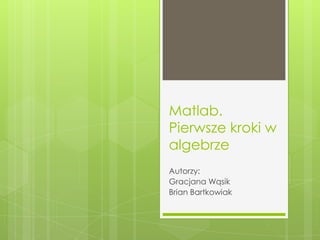
Matlab. Pierwsze kroki w algebrze.
- 1. Matlab. Pierwsze kroki w algebrze Autorzy: Gracjana Wąsik Brian Bartkowiak
- 2. Wprowadzenie wektora >>a = [1 2 3 4 5] i naciskamy ENTER Wskazówka: Jeśli za nawiasem umieścimy średnik wartości wektora nie zostaną wyświetlone, ale pozostaną w pamięci.
- 3. Wprowadzenie wektora Drugisposób. Można utworzyć wektor w pewnym zakresie o elementach oddalonych od siebie o tę sama wartość: >> b=[0:3:12] >> c=[1:5]
- 4. Dodawanie wektorów Do każdego elementu wektora można dodać(odjąć) liczbę, np. >> b=a+1 Albo dodać (odjąć) dwa wektory o tej samej długości: >> c=a+b
- 5. Operacje na wektorach max(x) zwraca największy element wektora x min(x) zwraca najmniejszy element wektora x sum (x) zwraca sumę elementów wektora x prod(x) – zwraca iloczyn elementów wektora x mean(x) – zwraca średnią arytmetyczną elementów wektora x
- 6. Wprowadzenie macierzy Macierz tworzymy podobnie jak wektor, ale: elementy w wierszu macierzy muszą być oddzielane spacją lub przecinkami średnik lub znak nowego wiersza kończy wiersz macierzy i powoduje przejście do następnego cała lista elementów musi być ujęta w nawiasy kwadratowe. >> A=[1 2 3; 4 5 6; 7 8 9]
- 7. Wprowadzenie macierzy Wierszemacierzy zachowują się jak wektory(bo to są wektory), tzn. >>A=[1:9; 2:2:18]
- 8. Wprowadzenie macierzy Macierze można wprowadzać także poprzez zmienne, tzn. C=[A;B] – składanie w pionie, C=[A,B] – składanie w poziomie, C=[A,B;B,A] – składanie mieszane
- 9. Operacje na macierzach X*Y – mnożenie macierzy, zgodnie z zasadami rachunku macierzowego (liczba kolumn X jest równa liczbie kolumn Y) X+Y – sumowanie macierzy X-Y – odejmowanie macierzy X’ – transpozycja macierzy
- 10. Operacje na elementach macierzy X.*Y – mnożenie elementów wektorów lub macierzy o tych samych indeksach tzn. X(i,j)*Y(i,j) X./Y – dzielenie elementów wektorów lub macierzy o tych samych indeksach tzn. X(i,j)/Y(i,j) X.^Y – podnoszenie do potęgi elementów wektorów lub macierzy o tych samych indeksach tzn. X(i,j)^Y(i,j)
- 11. Operacje na elementach macierzy >>C=A’ – transponowanie macierzy, >>C=A^(-1) – odwrotność macierzy, pamiętajmy, że macierz odwrotna istnieje tylko dla macierzy kwadratowych!
- 12. Generowanie macierzy X=eye(5) – macierz jednostkowa 5x5, X=ones(5) – macierz jedynkowa 5x5 , X=zeros(5) - macierz zerowa 5x5, X=rand(5) - macierz losowa 5x5, X=randn(5) - macierz losowa o rozkładzie normalnym 5x5, X=linspace(x1,x2,N) – wektor o wartościach rozłożonych równolegle X=logspace(x1,x2,N) – wektor o wartościach rozłożonych logarytmicznie
- 13. Dodatkowe informacje Macierz odwrotną wyznaczamy poleceniem : >> D=inv(A) jej wyznacznik: >> det(A) i wartości własne: >> eig(A)
- 14. Dodatkowe informacje >>A=diag(x) - macierz przekątniowa A ze składnikami wektora x na głównej przekątnej >>x=diag(A) - wektor x utworzony z elementów znajdujących się na głównej przekątnej macierzy A
- 15. Dodatkowe informacje: >> A(:,3) - wypisanie trzeciej kolumny macierzy A >> A(:,2:3) - wypisanie drugiej i trzeciej kolumny macierzy A >> A(:,2:-1:1) - wypisanie drugiej, a potem pierwszej kol. macierzy A >> A(:,2:1) - taki zapis daje wektor pusty >> A(2,:) - wypisanie drugiego wiersza macierzy A >> A(2:3,:) - wypisanie drugiego i trzeciego wiersza macierzy A >> A(:) - wszystkie elementy macierzy A jako wektor >> A(4:8) - elementy macierzy A od czwartego do ósmego >> A(end,:) - wypisanie ostatniego wiersza macierzy A >> X=A; X(2;:)=[] - usunięcie drugiego wiersza macierzy X >> Y=A; Y(1:2:8)=[] - usunięcie sekwencji elementów macierzy Y